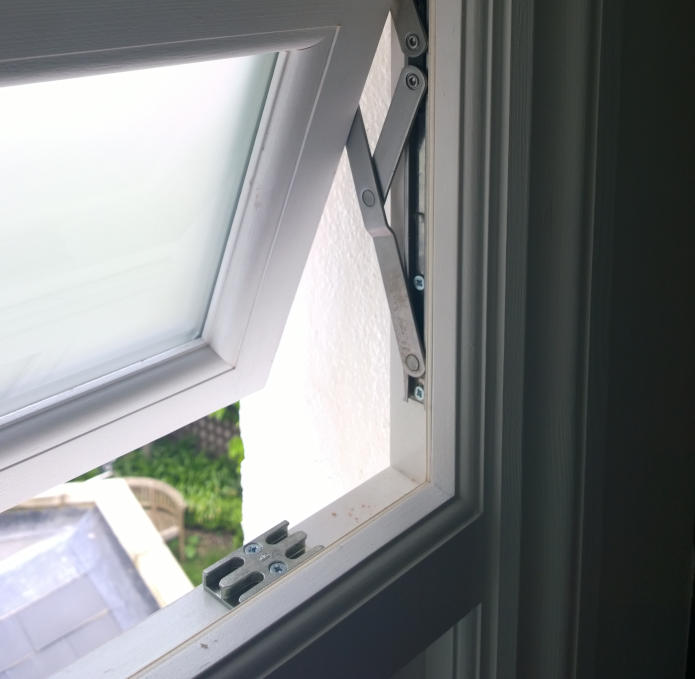Introduction: One Hardware, Two Worlds
Friction stay, also known as window stays or window hinges, are critical components in casement window systems. They allow the sash to open outward, support the window at different angles, and provide controlled resistance to wind pressure and movement. While they serve the same basic purpose across all settings, their design, specifications, and performance requirements vary significantly between residential and commercial applications.

Understanding these differences helps architects, builders, and hardware buyers select the right product for the right purpose—ultimately ensuring window safety, performance, and user satisfaction.
1. Friction Stay in Residential Projects
Key Characteristics:
Residential homes prioritize comfort, design, ease of use, and safety. Friction stays in this segment are typically used on smaller to mid-sized windows and are designed to blend functionality with aesthetics.
- Slim and Clean Design
Slim profiles that suit aluminum or uPVC windows and preserve the clean lines of modern residential architecture. - Easy Operation
Homeowners need windows that open and close effortlessly. Friction stays provide smooth movement and adjustable friction control for customizable resistance. - Corrosion Resistance
For homes in coastal or humid regions, corrosion-resistant materials like SS304 or even SS316 (marine grade) are essential for durability. - Integrated Safety Features
Options such as window restrictors help prevent children from opening the window too far—a key concern for multi-story homes.
Common Use Cases:
- Bedroom and bathroom windows (typically top-hung)
- Kitchen casement windows
- Small side-hung windows for ventilation
Recommended Friction Stay Sizes:
- 8″ to 12″ for small top-hung windows
- 14″ to 16″ for medium-sized openings
- 20″ for larger side-hung windows
Popular Types:
- Standard friction stays (basic open/close)
- Restrictor stays for child safety
- Easy Clean hinges for upstairs windows
2. Friction Stay in Commercial Projects
Key Characteristics:
Commercial buildings—such as schools, hospitals, office towers, and shopping malls—require more robust hardware to accommodate larger, heavier windows, increased usage frequency, and compliance with safety codes.
- Heavy-Duty Load Capacity
Larger glass panels or aluminum curtain walls mean heavier sashes. Commercial friction stays are designed to support higher loads, often exceeding 50kg. - Durability and Endurance
Unlike homes, commercial windows may be opened and closed hundreds of times per month. High-quality bearings and stainless steel materials (SS304/SS316) are essential. - High Opening Angles and Emergency Use
In high-rises or regulated environments, friction stays must allow windows to open up to 90°–180°, often for fire egress or ventilation compliance. - Cleaning and Maintenance Access
Many commercial buildings use Easy Clean or Egress stays that allow the sash to slide for external glass cleaning, particularly in restricted access areas.
Common Use Cases:
- Office tower windows (side-hung or top-hung)
- University campus buildings
- Hotels and healthcare buildings with egress regulations
- Public buildings requiring restricted or automated ventilation
Recommended Friction Stay Sizes:
- 20″ to 26″ or even custom lengths
- Enhanced arms with reinforced ribs or sliding shoes for added strength
Popular Types:
- Egress Friction Stays (for fire safety)
- Heavy-Duty Side Hung Friction Hinges
- Storm-Proof or High-Wind Resistant Models
3. Comparison Table: Residential vs. Commercial Friction Stays
| Feature | Residential Projects | Commercial Projects |
|---|---|---|
| Typical Load | 10–30kg window sashes | 30–60kg or more |
| Opening Angle | 60°–90° | Up to 180° |
| Material Used | SS304, powder-coated carbon steel | SS304 / SS316 / reinforced stainless alloys |
| Frequency of Use | Occasional | Frequent (daily use in public spaces) |
| Compliance Needs | Basic home safety | Egress, fire safety, energy codes |
| Window Type | Top-hung, side-hung casement windows | Curtain walls, ventilated systems |
| Hinge Types | Standard, restrictor, easy clean | Heavy-duty, egress, restricted friction stay |
4. How to Choose the Right Friction Stay for Your Project
Here are four quick tips to help you or your customers select the correct hinge:
- Measure the sash weight and size – Too small a hinge leads to early failure.
- Consider the operating environment – Use SS316 for coastal or chemically exposed areas.
- Check regulatory requirements – Fire escape windows require certified egress hinges.
- Don’t overlook frequency of use – Public buildings need high-cycle tested products.
